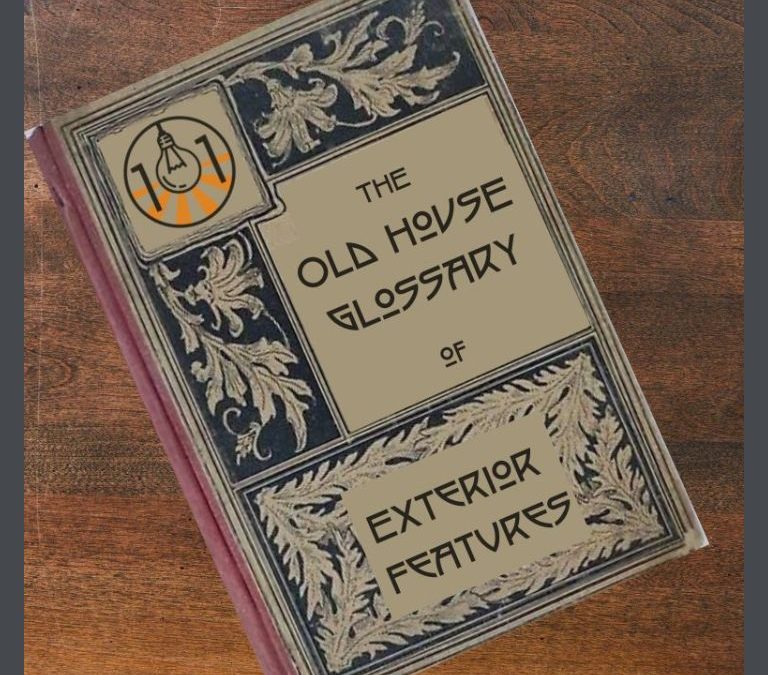
by bungalow101 | Dec 4, 2022 | Features
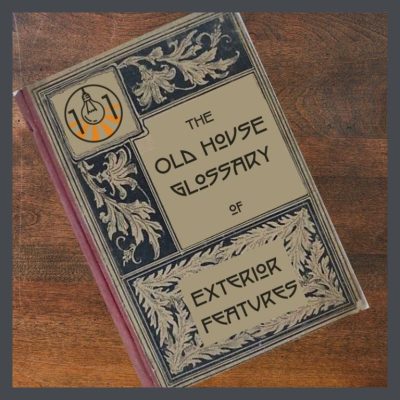 This bungalow details exterior glossary will help you get a rapid grasp of what makes a bungalow a bungalow, & not a Mid-Century, a Queen Anne or a Dutch Revival. Many of the terms are applicable to other styles of homes, & some to all periods of architecture & it’s not bad to know them if you love old houses like I do. It’s easier to sing the song if you know all the words. To get really acquainted with all the magic of bungalows, begin at the beginning. Please let me know if you run across any terms in your study of bungalows that are not defined here, or if you should find any of my explanations incomplete or difficult to understand, I’d like to know that too. I studied architecture on my own & would have loved to have had a glossary when I was reading books about it. After stumbling about, I decided to create my own. Regional terms also threw me when I moved from California to Florida.
This bungalow details exterior glossary will help you get a rapid grasp of what makes a bungalow a bungalow, & not a Mid-Century, a Queen Anne or a Dutch Revival. Many of the terms are applicable to other styles of homes, & some to all periods of architecture & it’s not bad to know them if you love old houses like I do. It’s easier to sing the song if you know all the words. To get really acquainted with all the magic of bungalows, begin at the beginning. Please let me know if you run across any terms in your study of bungalows that are not defined here, or if you should find any of my explanations incomplete or difficult to understand, I’d like to know that too. I studied architecture on my own & would have loved to have had a glossary when I was reading books about it. After stumbling about, I decided to create my own. Regional terms also threw me when I moved from California to Florida.
This glossary has been side-checked by Jo-Anne Peck of Historic Shed. Jo-Anne has an undergraduate degree in Building Science, a Masters degree in Historic Preservation & is a certified Florida Building Contractor who has been involved in consulting, design & construction for historic buildings for over 25 years. If a definition needs more than just an image, I’m linking you to my YouTube Channel because I have scooped up some great information on my playlist. Again, alert me to any good ones I may have overlooked. I’m working on a glossary for interior terms & will link it here also when it’s complete.
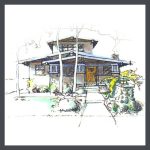
Airplane Bungalow
This type of bungalow features a large, single room on the second floor, generally surrounded completely by windows, designed to be for sleeping in warm weather.
When I go out toodling around shooting bungalows, I look for airplanes because they often have other interesting features.

Bay Window
A window generally, of three wall segments. The two side wall segments are attached to the main wall of the home & project at an angle. A wall section is built parallel with the home’s main wall. Each wall section contains a window (or windows).

Beadboard
Though used inside, eaves & porch ceilings are typically built of beadboard, a tongue & groove paneling with a small beaded groove running along the length. The little indentation or ridge is the “bead.”
Beam
A framing member usually significantly larger than other framing members that carry roof or floor loads over a certain span.

Birdsmouth Joint
A triangular-shaped cut that allows a rafter to sit squarely on the framing.
Bungalow
See this Post

Camber beam
A piece of timber cut archwise. It is much stronger than another of the same size, since being laid with the hollow side downwards, as they usually are, they form a kind of supporting arch.
Casing
Pieces of wood trim surrounding a window or door. It can range from very plain to quite elaborate depending on the home style.

Casement Window
A window that pivots on a side hinge much like a door with a handle to crank the window open.
Character defining features
The visual and physical features that give a building its identity & distinctive character, i.e., why we love bungalows!
Clapboard
Also called bevel siding, lap siding, or weatherboard, depending on the region, clapboard is wide wood siding usually overlapping, installed horizontally to form exterior walls. Why is it called clapboard? The word comes from the Dutch klappen, which means “to split.”

Clinker bricks
Bricks that are produced when wet clay bricks are exposed to excessive heat during the firing process, forming a shiny, dark-colored coating, giving them a blackened appearance. They are usually irregular in shape, often misshapen or split. Clinker bricks are used Arts & Crafts houses to add interest.

Clipped Gable
Or jerkinhead roof (it’s much more fun to say jerkinhead). Instead of ending with a point, it is flattened at the end with a small hip. This feature reduces wind force on facades, probably why you see so many of them in Flor-ee-da.
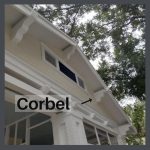
Corbel
A weight-bearing architectural element that projects from the wall & supports a structure above it, especially one that is stepped upward and outward from a vertical surface. They can be used as support or decoratively. Also called an outrigger.

Corner boards
Trim boards placed at the outside corners of a house; most commonly used with wood siding.
Craftsman
An architectural or interior style, inspired by the Arts and Crafts movement, & brought to America by Gustav Stickley. This is a good video that will help you more completely understand what a Craftsman House is.

Dentil
A decorative molding using evenly spaced rectangular blocks. A row of dentils can project from beneath the roof line of a building, in ceilings, furniture & it is also seen in built-ins.

Dormer
A projection of vertical walls through the sloped roof plane with or without a window & its own roof ties into the home’s main roof. Dormers allow the natural light & ventilation to enter into upper floors or attic spaces.
Double-hung window
This is the type of window that you will most see in bungalows. They are composed of 2 sashes, one over the other & are built to slide over one another, each one opening independently. Rather than trying to show or to ‘splain it to you, see can them here, doing their slidy thing, in this great video.

Eaves
The lower part of a roof plane extends outward from the structure at the same slope as the roof & is generally finished with a fascia board. Sometimes referred to as the roof overhang. The eave on a gable end is sometimes referred to as the gable overhang.

Eave brackets
Often triangular in shape, eave brackets are used at the gable ends of a roof to help support the roof overhang. They can be decorative or structural.
Edge Flashing
The metal trim that is placed on the edge of the roof covering the seam between the roof plan on the eave & the fascia board. Sometimes referred to as drip edge.

Fascia
A horizontal board positioned on edge & attached to the ends of the rafters or truss ends where gutters are typically supported. This is called an eave fascia. Fascia placed on the end of a gable roof end is called gable fascia.

Folk Victorian
A more practical & affordable version of the typical ornate Victorian, seen in the U.S. from around 1890-1910, influencing typical bungalow design.
Footing
A footing supports foundation or bearing walls carrying the weight of upper floors, roof structures, etc. A footing is generally wider than the foundation or bearing wall & is constructed on undisturbed soil to achieve the maximum stability possible. Footings run continuously under all bearing & foundation walls or intermittently under piers.
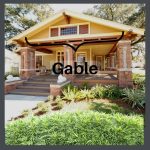
Gable
A triangular portion of a wall between the edges of intersecting roof pitches, or slopes. A clipped gable has its point “clipped” off.
Gable roof
A pitched roof terminating in a gable at one or both ends.
Gutters
A channel attached to the fascia board designed to carry away water that runs off the roof surface. Read the article about why they are important to maintaining the condition of your foundation.

Hipped roof
A roof that slopes in 4 directions, like a pyramid.
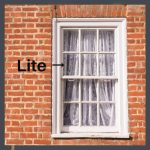
Lites
Separated glass areas in a window, usually separated by some sort of grid pattern.

Mortise & tenon
A type of joint used in building structures or furniture that connects two pieces of wood or other material, having two parts, the mortise hole which has a hole & the tenon which has a tongue. The joint may be glued, pinned, or wedged to secure the pieces together. .
This joint is also used with other materials. For example, it is traditionally used by both stonemasons and

Mullion
Vertical pieces of wood that separate 2 windows that sit side-by-side.
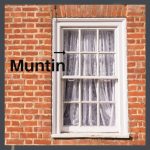
Muntins
Vertical & horizontal strips that divide a window’s glass into a grid, or diagonally, into a lattice pattern. They provide stability & support to panes of glass, & were initially used when manufacturers of the past, needed to use several smaller panes to create a large window.

Outrigger
A horizontal brace for the gable eaves. This house in the photo above has 3 outriggers on the front porch gable. Also referred to as a corbel.
Pier foundation
A series of masonry supports that act as the building or porch foundation & allow air flow under the building. Typically used in warmer climates where ground freezing is not an issue. You can read more about foundations here.

Pony wall
A short wall, typically 3′ in height. The term is often used interchangeably with “knee wall” or “cripple wall.” You can see them on porches & as walls that serve as guards on stairs or balconies.

Porte- cochere
A roofed structure extending from the side of the house, usually from the porch, over the driveway to provide shelter when you are coming from the car into the house.

Portico
A small porch, usually just over the door.

Profile
A shape that is applied to the edge of a piece of wood such as a door or window frame, exterior or interior trim or a window or door jamb. This creates shadow lines and visual interest in the trim piece.
Rabbet
To cut a step-shaped recess along the edge or in the face of a piece of wood, typically forming a match to the edge or lap of another piece.). Here’s a video that explains it perfectly!
Rafter
A framing member, immediately beneath the roofing material extending from the perimeter wall to the ridge of the home. The rafters support the exterior roof surface. They are often left exposed on Craftsman style bungalows.

Rafter tail
Portion of a rafter that projects beyond the exterior wall to support the eaves (often cut into decorative designs when left exposed.)
Ridge
The highest part of a roof where the sloped roof planes meet. Sometimes referred to as the roof peak.

Sash
A window frame. A sash window is made of one or more movable panels or “sashes” that hold panes of glass, which are often separated from other panes (or “lites”) by narrow wood strips (or “muntins.”) A double-hung window has 2 panels or sashes.
Shed Roof
A single sloped roof section which covers an entire area. Structures are often covered by several shed roofs sloping in various directions. Dormers are also often covered with shed roof sections.
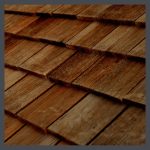
Shingles
A small, thin piece of wood, thinner at the top & thicker toward the bottom, that are laid in staggered, overlapping rows as a covering for the roof or sides of a house.
Shotgun house
A narrow house that has a gabled front porch & 2 or more rooms laid out straight behind it. The rooms are connected without hallways. This type of house has doors at each end of it, front & back.

Siding
The exterior material applied to the walls of a house or other building meant to shed water, protect the walls from the effects of weather, insulate, & is key in the aesthetics of the structure.

Soffit
The underside area of a building arch, balcony, or an overhanging eave.
Story book
Houses built to look like where Hansel & Gretel & friends could have lived.

Transom window
A window that is placed above a doorway.
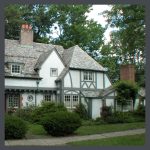
Tudor
Usually stone or a light-color stucco, Tudors feature peaked gables & two-toned exteriors, dressed up with half-timbering.
Window sill
The bottom horizontal trim member at the base of a window projecting outward.
 STAY IN THE BUNGALOW KNOW!!!
STAY IN THE BUNGALOW KNOW!!!
Sign up for our newsletter & receive our FREE E-book, 7 VITAL Things to Do Before You Hire a Contractor.

by bungalow101 | Nov 29, 2022 | Places to visit
 Florida’s history museums & historic museum houses tell a 3D tale of the state & the land boom of the 20’s that cannot be fully expressed in any book, though I have to admit that I did a pretty good job in the historic documenatry film I produced!
Florida’s history museums & historic museum houses tell a 3D tale of the state & the land boom of the 20’s that cannot be fully expressed in any book, though I have to admit that I did a pretty good job in the historic documenatry film I produced!
The financial momentum of the times was astonomical! I am not trying to lure you away from my blog, but this page clearly explains the culture of the times. It is a fascinating & enlightening read.
Welcome back!
A great many of these homes were bungalows, a style not too different from the houses built by the early settlers, with deep porches, prominent overhangs & an abundance of large windows. After several years of coaxing, American Bungalow Magazine came to Florida & featured homes in 4 neighborhoods in the central part of the state. You can read about them on my Instagram page.
DUNEDIN
 Dunedin History Museum
Dunedin History Museum
“Where History Comes Alive”
I love this friendly, quirky little museum. The last exhibit we saw there was “Jagged Lines: America’s Tattoo Tradition,” focusing on the evolution of tattoo art.
The Museum collections contains approximately 2,000 artifacts, 2,500 photographs, & a library of 200 volumes of local & State history. Their permanent exhibits feature statewide topics such as the railroad & citrus industries, but the best ones are regional topics such as Dunedin’s multicultural origins, pioneering families, & even the story of the development of the alligator tank used by the U.S. Marines during WWII in the Pacific.
LARGO
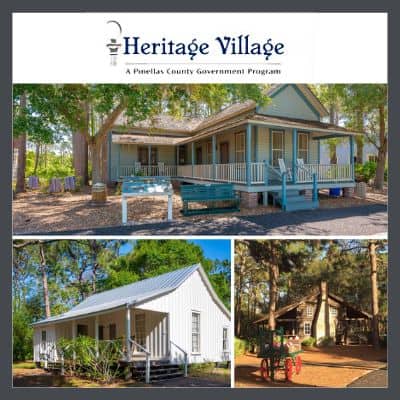 Heritage Village
Heritage Village
Explore this 21-acre living history museum located in its natural pine and palmetto landscape. Included amongst the structures & exhibits is the Turner House, built in 1915, of the Florida vernacular bungalow style of that time period.
The house was bequeathed to the County, along with $100,000 in moving costs & the contents of the 1915 bungalow. Now let me explain when I say contents- 6 pages of documented items, including: “furniture, accessory items, lighting, artwork, mirrors, wall pieces, toys, school memorabilia, linens, clothing, shoes, hats, costume jewelry, kitchen furnishings, tableware, cameras, clocks, radios, fans, china sets, glassware, serving pieces, decorative glass, pottery, vases, figurines, Belleview Biltmore items, sporting goods & more.
Some of the notable items include an 1860 quilt, silver plate flatware set from 1921, state license plates from 1949-1953, a child’s pedal car from 1933 and a 1940 Clearwater High School class ring.”
These items are on display at the museum of the grounds & sweep you into the life of this family whose story is told in photos, maps & sign around the museum. The house is not yet open, needing much work to make it safe, so stop by & pitch in a nice donation so that you’ll be able to actually tour the house in the future.
TAMPA
 Tampa Bay History Center
Tampa Bay History Center
A Smithsonian Affiliate museum, the History Center includes three floors of permanent and temporary exhibition galleries in 60,000 square feet, focusing on 12,000 years of Florida’s history, heritage & culture, focusing on Tampa Bay.
It offers many permanent & changing exhibits as well as activities in which you can learn about the area, including:
Docent-guided walking tours of Tampa’s historic sites and neighborhoods,
A monthly book group focused on Florida literature. The event is free with registration,
Florida Conversations is a free, monthly lecture series highlighting research into Florida history,
As well as many activities for children & teens.
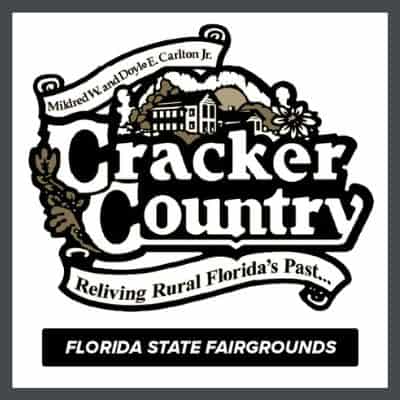 Cracker Country
Cracker Country
I discovered Cracker Country, a living history museum of old rural buildings from the late 19th Century, which were relocated to the Florida State Fairgrounds when we had come to see the fair, but I was much more interested in the old buildings & demonstrations of early settler skills than in rollercoaster rides. (Well, not really. I was there for the gardening displays, the crafts & the corn dogs.)
The key features of living in Florida are the heat & humidity & the resultant awful creatures. The homes of Cracker Country display great ingenuity of design in creating dwellings in which people could experience some degree of comfort through shade, ventilation & elevation.
You can see the bungalow in these early designs. Our homes here in Florida, tend to have large porches, & deep overhangs, tall windows & lots of ‘em!
Ybor City Museum
In 1886, when Tampa was mostly pine scrub. cigar manufacturer & entrepreneur Don Vicente Martinez Ybor came from Cuba via Key West to found Ybor City, the “Cigar Capital of the World.” This museum, housed in the historic Ferliia Bakery, (built by another old Tampa family in 1923 after the original building from 1835 was destroyed by fire) & urban park are dedicated to the preservation of Ybor City’s unique cultural heritage.
In addition to their great collection of artifacts, you can often see demonstrations of cigar rolling but the very best part is the film about the area which sweeps you back to the birth of historic of Ybor City.
TARPON SPRINGS
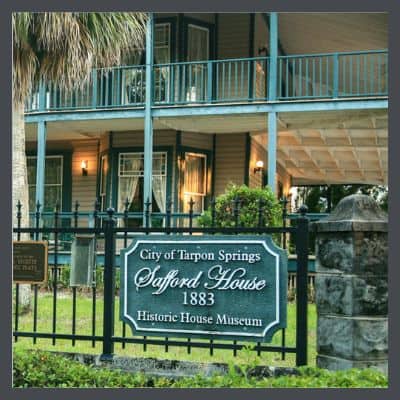 The Safford House Museum
The Safford House Museum
Although the main draw in Tarpon is the sponge docks & commercial/tourist area, I enjoy trotting around the historic downtown area & driving through the old residential areas built in the late 1800- early 1900’s.
A great attraction is the 1883 Safford House Museum, restored to its original Victorian splendor, which was the home of one of the city’s original developers. Listed on the National Register of Historic Places, the house is a fine example of late 19th century Florida vernacular architecture, & complete with period furnishings & family possessions, it provides the full flavor of upper-class living in the state as it was developing.
Take the opportunity to visit Florida’s history museums & historic museum houses. It’s the only way to discover the true flavor of the Sunshine State.
If you’re a local, all these museums & homes need your volunteer skills. Your participation will provide you with a great learning experience & reward you with warm friends as mine did.
TIP: Read my article about the wonderful historic places to visit in Sarasota HERE.
 STAY IN THE BUNGALOW KNOW!!!
STAY IN THE BUNGALOW KNOW!!!
Sign up for our newsletter & receive our FREE E-book, 7 VITAL Things to Do Before You Hire a Contractor.
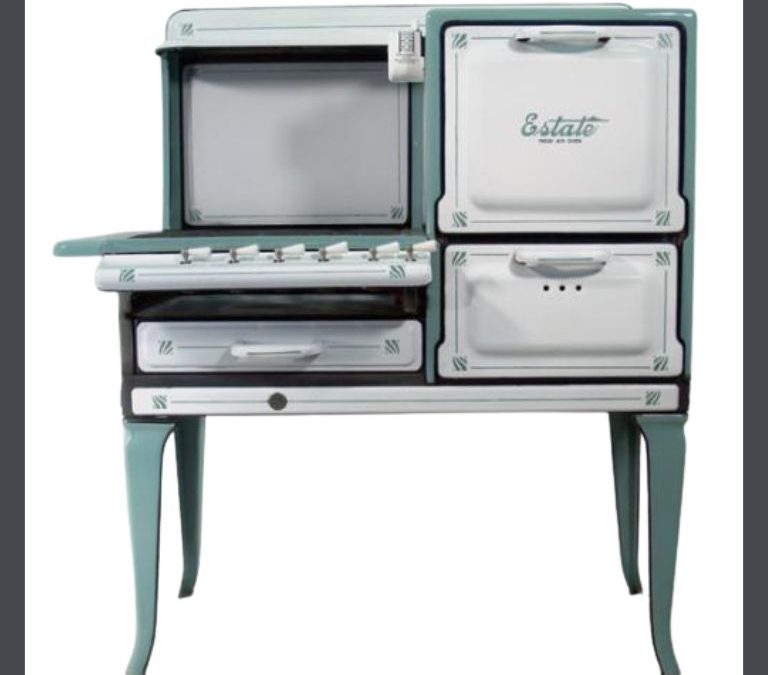
by bungalow101 | Nov 8, 2022 | Kitchens
PUTTING IT ALL TOGETHER
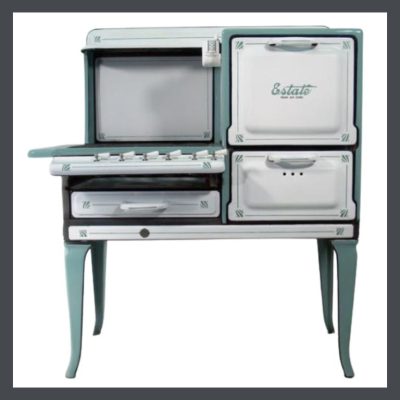 Clutching my well worn BUNGALOW KITCHENS book, I began collecting the pieces for my dream bungalow kitchen in Tampa. The first was the stove because I knew that it would take 2 ½ years to be restored, all the way in Georgia. When I had lived in L.A., there were several antique appliance sources, one within walking distance, where you could just walk in & buy an old stove.
Clutching my well worn BUNGALOW KITCHENS book, I began collecting the pieces for my dream bungalow kitchen in Tampa. The first was the stove because I knew that it would take 2 ½ years to be restored, all the way in Georgia. When I had lived in L.A., there were several antique appliance sources, one within walking distance, where you could just walk in & buy an old stove.
Not so in Tampa. I found the exact stove I wanted on eBay in New England, & they shipped it to Georgia. I was at high anxiety about her little Queen Anne legs, having seen plenty of stoves with damaged ones & begged the shippers to be gentle with these delicate appendages. When it arrived in Georgia, I called the owner of the restoration shop for a status report & all was well with the lady’s gams. I set the timer for 2 ½ years. Tick. Tick. Tick.
The next step was the sink. I really wanted a green sink. I searched eBay, Etsy, Craigslist, local salvage yards for over a year. Every week I diligently scrolled, called & searched for my sink. I saw some very cool sinks, many of which would have worked well in my kitchen but I was intent on using jadeite green. For many years I have been stuck on yellow or red & white in bungalow kitchens but for some reason, those colors just no longer appealed.
 Finally, there it was on eBay. Not only was it green, but it had clipped corners, like the gable of my house! I outbid the competition & had the huge, heavy, expensive sink shipped to me where I put it in storage, awaiting the 2 ½ years until my stove would be ready, to pass. Only 1 ½ years left to go!
Finally, there it was on eBay. Not only was it green, but it had clipped corners, like the gable of my house! I outbid the competition & had the huge, heavy, expensive sink shipped to me where I put it in storage, awaiting the 2 ½ years until my stove would be ready, to pass. Only 1 ½ years left to go!
On to flooring. I had, long before, admired a green checkerboard floor in Jane Powell’s LINOLEM . I am a big fan of lino but, I also really like the resilience of cork, which is available in limited colors. It was not easy to get samples of either of these materials. What was common in L.A. was down-right weird in Tampa. Fortunately, we carried 2 lines of cork in my flooring company which allowed me to get my samples directly from the manufacturers.
The linoleum experience was pretty funny. I called a flooring store that mentioned lino on their website. I was very explicit- linoleum, not vinyl. Do you know the difference? “Absolutely! We have samples in many colors.’
I grabbed my keys & trotted out the door. When I arrived at the showroom, I was directed to a large display of, you guessed it- vinyl. The salesman thought that they were the same material. He was very confused. Fortunately, the next store had real lino & I got my samples.
THE DREAM BUNGALOW KITCHEN COLLECTABLES FRENZY
 Meanwhile, I accumulated mountains of kitchenalia- old mixers, toasters, coffee pots, cooking implements. All in my beautiful jadeite green. My biggest addiction was potholders- kitty potholders. It got to the point that I was wondering if I would need to build a kitchen annex to display them!
Meanwhile, I accumulated mountains of kitchenalia- old mixers, toasters, coffee pots, cooking implements. All in my beautiful jadeite green. My biggest addiction was potholders- kitty potholders. It got to the point that I was wondering if I would need to build a kitchen annex to display them!
I also had quite a kitty teapot problem. The thing with the internet is that one can amass a lifetime collection of about anything in a matter of hours. And I did! Over the course of 2 ½ years I gathered several lifetimes of kitty teapots. I paused only long enough to add to my kitty pillow collection. At least I had a bed on which I could display them!
Poor Hubby, every day boxes of this stuff arriving, none of which made any sense to him.
Then there was the cabinet jewelry. When I outfitted my 1910 Craftsman in Eagle rock, I formed a friendship with my hardware specialist at House of Antique Hardware, Jennifer. She assisted me in choosing lighting & in finding replacements for some of my other hardware. If they didn’t have exactly what I needed there, she would search it out for me through the many connections she had developed in her decades in the industry. She truly lived up to her title of hardware specialist again & again.
 Turned out that her sister had a winter place in St. Pete so when Jennifer came to visit her, we would get together & she & I would talk old houses & her sister & my husband would talk food. (Sister introduced Hubby to his favorite restaurant in Tampa Bay.)
Turned out that her sister had a winter place in St. Pete so when Jennifer came to visit her, we would get together & she & I would talk old houses & her sister & my husband would talk food. (Sister introduced Hubby to his favorite restaurant in Tampa Bay.)
Because I never got it together to restore my Craftsman kitchen, I decided to use knobs & pulls in my 1925 Mid-Century Modest that were wholly inappropriate. I had planned to use these in clear in the Craftsman & wanted the green for the 1925’er.
My dear friend Jane Powell was a preservation bulldog, however, she left the door open by saying that anything was fine if it had a really good backstory. I consider this to qualify as a really good backstory. Heck, when she restored her own kitchen in the Sunset House, she used an antique candy store display case as a kitchen island & she was delighted with it!
On this page you will see many pictures of Jane’s beloved bunga-mansion, an altogether imposing house. One of the things that I admired about Jane was that she was so at home in this house & so not overwhelmed by its size, & frankly, the discomforts of living in an very old, partially restored mansion. As beautiful as it is, the stairs are steep, you can get lost in all the rooms, & it’s really cold. The last time we were there was just before Christmas & I shivered all night long under 3 folded double blankets.
THE BUNGALOW KITCHEN DREAM CRUSHER
Mid the 2 ½ year wait for the stove, surrounded by my lino samples, my sink, my potholders & my green glass hardware, the Recession hit. Construction shrank by 86% in Florida. That left all of us scrambling for the remaining 14%. We lost $50,000 on a Victorian we had restored. I was on the sidewalk every weekend, yard saleing my childhood dolls, Grandma’s pressed glass & my Christmas decorations to make my payroll.
When the stove restoration was finally complete, we carted it home & parked it in a corner in the ugly kitchen. After the financial hit of the Recession, I couldn’t justify the expense. Additionally, working 80 hours a week, I never had a spare minute to put it all together. When we sold the house, I finally admitted defeat, donated the sink to Habitat & sold the stove, the potholders & the kitchen implements.
BUNGALOW KITCHEN DREAM REDEMPTION
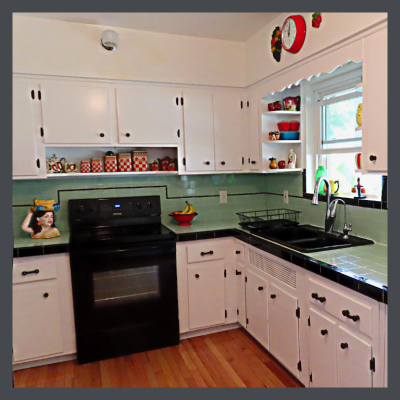 I blog about bungalows because I have been talking, writing, advocating & educating for & about them incessantly over the past 20 years & living in them for over 40. I should have been blogging about them since the dawning of the Age of the Internet. It took searching my heart, house bound in a world-wide pandemic, for what brought me joy to get me started blogging, but better late than never!
I blog about bungalows because I have been talking, writing, advocating & educating for & about them incessantly over the past 20 years & living in them for over 40. I should have been blogging about them since the dawning of the Age of the Internet. It took searching my heart, house bound in a world-wide pandemic, for what brought me joy to get me started blogging, but better late than never!
After experiencing too many hurricanes in a frame house, I now live in a 1955 block, Modest Ranch. (The pink 50’s sink- remember?) This house when I purchased it, was almost completely original. The kitchen had been messed with so I put it right again & I used my 1910 glass hardware (in black) because, by golly, I have a good backstory!
This article is all about my long hoped for bungalow kitchen. Thanks to my blog, I got to put it together & show it off to hundreds of people.
Thank you, gentle readers. You have mended my broken heart.

STAY IN THE BUNGALOW KNOW!!!
Sign up for our newsletter & receive our FREE E-book, 7 VITAL Things to Do Before You Hire a Contractor.
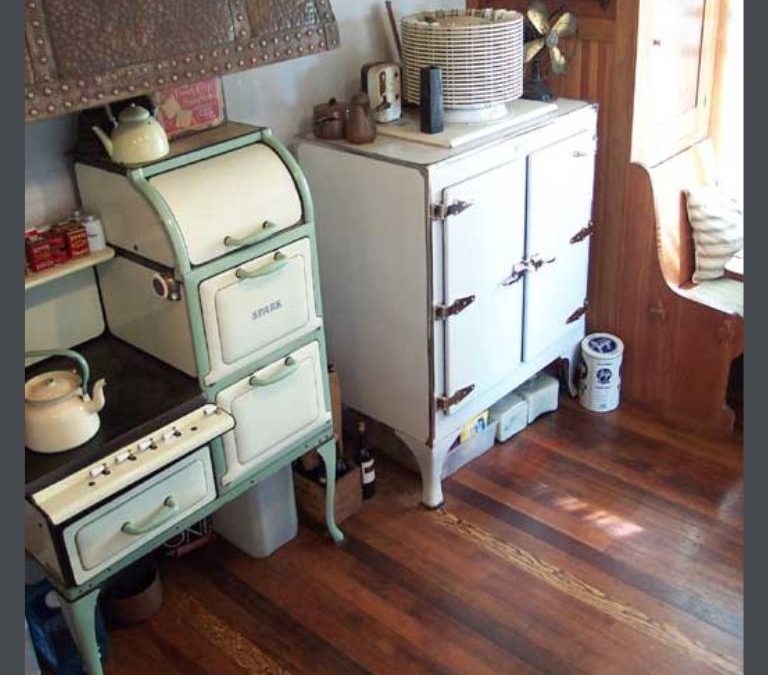
by bungalow101 | Nov 2, 2022 | Kitchens
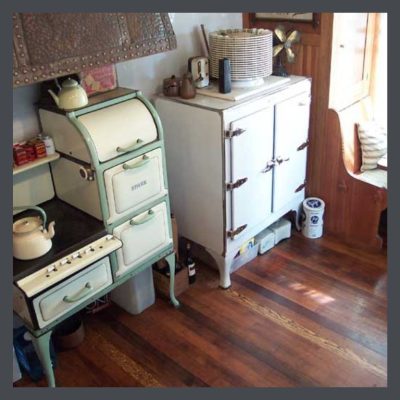 Time to grab your Kleenex box. Creating a bungalow kitchen never got any further than the dreams stage for me. I’d had my nose buried in Jane Powell’s BUNGALOW KITCHENS for a number of years & wanted nothing more (maybe world peace, but that’s about it) than an authentic kitchen.
Time to grab your Kleenex box. Creating a bungalow kitchen never got any further than the dreams stage for me. I’d had my nose buried in Jane Powell’s BUNGALOW KITCHENS for a number of years & wanted nothing more (maybe world peace, but that’s about it) than an authentic kitchen.
All of my friends had restored or original kitchens & I was feeling like the red-headed stepchild of the historic preservation communinity. Make that 2 historic preservation communities!
The one to the left is in a landmarked house in Eagle Rock, California, created by 2 plein air artists who were as dedicated as I to authentic restoration. With my ability to pick up the phone & talk to anybody, I gotten their house featured in American Bungalow Magazine.
My first friend in my new neighborhood in Tampa, Florida, Steve, who was head of the Historic Preservation Committee for the neighbor association had an original kitchen in his beautiful Craftsman. He lived down the street from me & I often tortured myself by visiting his beautiful house & peeking in his California cooler.
MY HOUSE & ITS HIDEOUS, VERY UN-BUNGALOWY KITCHEN
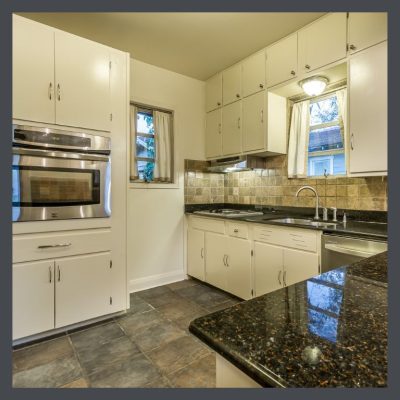 Before buying my Tampa bungalow, I was house-shopping & had seen a nice looking 1925 bungalow listed for a couple months, but I was truly repelled by the kitchen, (& I didn’t even know about the roaches yet! Get ready for the icky part.) knowing that it was part of the inflated price I would have to pay only to come in & tear out that black marble & chunky tile, not to mention the (mismatched) stainless appliances, to create the bungalow kitchen of my dreams.
Before buying my Tampa bungalow, I was house-shopping & had seen a nice looking 1925 bungalow listed for a couple months, but I was truly repelled by the kitchen, (& I didn’t even know about the roaches yet! Get ready for the icky part.) knowing that it was part of the inflated price I would have to pay only to come in & tear out that black marble & chunky tile, not to mention the (mismatched) stainless appliances, to create the bungalow kitchen of my dreams.
Not having central air, yes, in Flor-ee-da, the house had languished on the market for several months & one day when I’d been out house-hunting, it was open. What the heck. I went in & fell in like with the house. It now had A/C & though there were a few things to deal with, it had a nice, big living room for committee meetings, a good layout & was only 1 block away from my new friend, Steve. By this time, I was desperate enough & the price was low enough, I went for it. And it was in a historic district, so I knew that it would increase in value.
The house had a large, hideous kitchen, a perfect blend of 70’s jalousie windows, solid wood cabinets from maybe the 50’s, tile flooring, counter & backsplash from the 90’s, & fancy-schmancy Home Depot pendant lights from probably 2 days before the house was put on the market. The black marble countertops were especially awful. Before we got the house sealed it featured nightly invasions of palmetto bugs. This is a local species of the cockroach- huge & flying- & they felt right at home, camouflaged by the black countertops.
The kitchen did have its original door to the back porch & the original door to what had been the butler’s pantry & was now the grodiest ever pantry/laundry room/HVAC unit.
The kitchen layout was very awkward & I was clueless as to how it had ever been configured. There was now a cooktop & a wall oven so all hints of its original incarnation were annihilated long before.
JANE POWELL- THE QUEEN OF CREATING A BUNGALOW KITCHEN ARRIVES
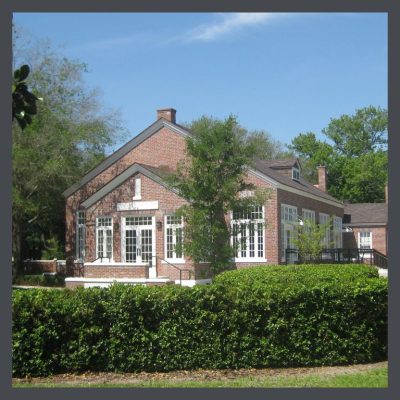 After seeing all the destroyed & neglected properties during my house hunting, I decided that the people of Tampa needed to get a little education about restoring bungalows-‘specially kitchens. So, I proposed to the neighborhood association that Jane should be invited to come & speak at an educational event, topic: Creating a Bungalow Kitchen! One of the board members was thrilled. He knew of Jane’s books & even had a Jane kitchen. The proposal was accepted. (They didn’t know me yet & had no idea how this would open the door to my wild my future proposals!) & a couple weeks after I moved in, Jane arrived.
After seeing all the destroyed & neglected properties during my house hunting, I decided that the people of Tampa needed to get a little education about restoring bungalows-‘specially kitchens. So, I proposed to the neighborhood association that Jane should be invited to come & speak at an educational event, topic: Creating a Bungalow Kitchen! One of the board members was thrilled. He knew of Jane’s books & even had a Jane kitchen. The proposal was accepted. (They didn’t know me yet & had no idea how this would open the door to my wild my future proposals!) & a couple weeks after I moved in, Jane arrived.
My kitchen conundrum was no match for Jane. In 3 seconds she had the space planned so beautifully that I wondered why I had never figured it out. Suddenly, it seemed so obvious how I could create my dream bungalow kitchen.
Her packed-to-the-rafters event at our beautiful, historic garden center went off without a hitch & we spent the 3 days after driving around doing kitchen consultations, 2 other events & teaching a class in interior design. Well, I drove & she consulted, spoke & taught. It was rather awful to take her to the airport for her return flight home, but I connected with the head of our county library system & they bought 50 books- 10 in each title. With that, I felt like I had put a little bit of Jane in Tampa & looked forward to having my own Jane Powell kitchen.
I still missed her.
 STAY IN THE BUNGALOW KNOW!!!
STAY IN THE BUNGALOW KNOW!!!
Sign up for our newsletter & receive our FREE E-book, 7 VITAL Things to Do Before You Hire a Contractor.
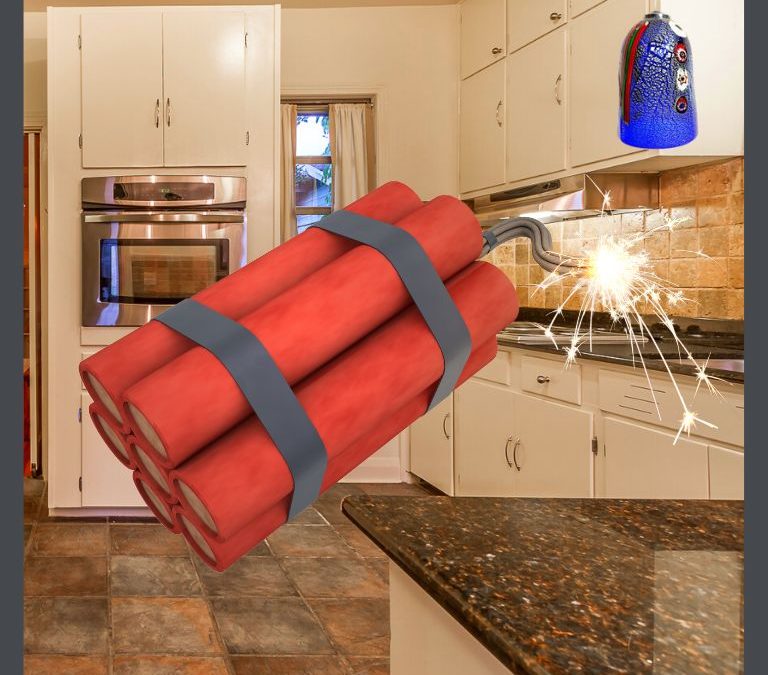
by bungalow101 | Sep 16, 2022 | Kitchens
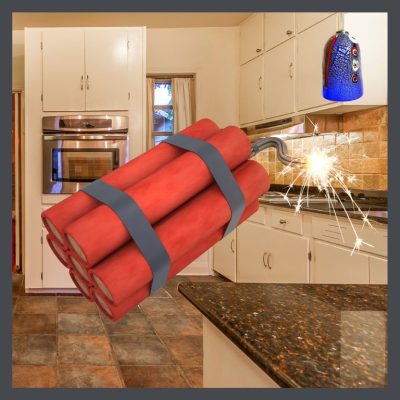 You are so ready for your bungalow kitchen makeover. Your current kitchen is a confusing mash-up of several decades of “updating,” a chronicle of the latest trends & a vivid tale of too many decades spoiling the broth. Yeah, that was my kitchen & the broth was more like toxic sludge.
You are so ready for your bungalow kitchen makeover. Your current kitchen is a confusing mash-up of several decades of “updating,” a chronicle of the latest trends & a vivid tale of too many decades spoiling the broth. Yeah, that was my kitchen & the broth was more like toxic sludge.
Your lighting is a row of colorful art glass pendants from Home Depot, marching over your countertop, surely installed by the seller because the house had been on the market for some time & her Realtor told her to zhuzh up the kitchen. Your countertop is 80’s shiny black granite with a backsplash of some sort of fake stone with tiny holes in it- kind of a bumpy lava rock that is really hard to keep clean. Your flooring is grey stone tile from the early 2000’s, again bumpy & a challenge to wash. The cabinets are solid wood, probably from the 50’s, but are configured very oddly. And the windows are metal jalousies from the 70’s, that don’t even work. And then there are the stainless steel appliances- the built-in stove, the cooktop & the huge stainless refrigerator lurking in the corner. Yeah, me again.
So how would you even begin to create a beautiful kitchen?
Dynamite is not an option. This is just a picture.
HARMONY-THE KEY TO A BUNGALOW KITCHEN MAKEOVER
 So let’s examine this concept, shall we? Harmony is a principle of art which refers to how well all the visual elements share some similarity- color, shape, mood, texture, theme, time period- & work together. Elements which are in harmony will have some kind of logical progression or relationship. They will integrate- go together to form a pleasing whole.
So let’s examine this concept, shall we? Harmony is a principle of art which refers to how well all the visual elements share some similarity- color, shape, mood, texture, theme, time period- & work together. Elements which are in harmony will have some kind of logical progression or relationship. They will integrate- go together to form a pleasing whole.
During my teen years, we used to use the word “clash” to express disharmony. One of the definitions of the word is, “a violent confrontation.” We used it to simply mean, “look ugly together.” I have to say that I have seen styles together that are worse than ugly. They are clearly at war!
Here’s an example. You go in a baby’s room & it’s painted a soft color, there’s the crib with the baby blanket it, the soft mobile, the floral stencils on the wall. It all makes sense. There’s no life size stand up of a heavy metal rock star positioned so baby can see it when she awakens from her nap. And why not? If there is an element which is not in harmony with the rest of the artwork, it will be jarring- a flat note in a song, a pig’s head on a horse’s body, plastic handles on a Ming vase- heavy metal in the baby’s room. Clang!
OLD HOUSE HARMONY
In historic structures, the harmony is created by the use of the different elements which denote the time period- shapes, materials, proportion, layout. These were determined by the builders of the era based on the factors present in the culture & the technology of the time period. Get it? A logical progression or relationship based on a time period. Individually, these are called, “character-defining features,” those visual & tangible aspects of the historic building which tell its unique tale- time period, place, demographic, etc. They all work in harmony to create a visually appealing aesthetic. It’s basic design theory. Cultures, fashions & technologies change, creating trends. That’s why when you walk into a bungalow with an avocado 70’s kitchen, you have a strong reaction to it. And not a good one! It’s a flat note. Your first instinct when you start your bungalow kitchen makeover is to tear it out & donate it to landfill. Here’s a great article on bungalow vibe, written in 1901, that will provide a solid understanding of how to achieve bungalow harmony.
DECIDING ON THE NEW BUNGALOW KITCHEN MAKEOVER ELEMENTS
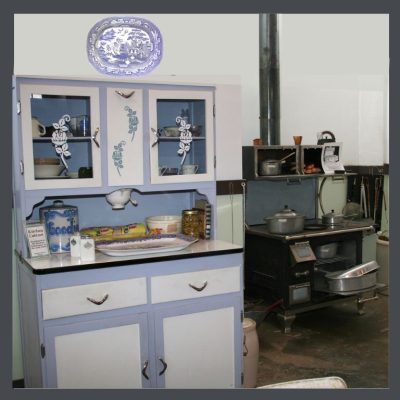 Twenty years from now, that new, shiny, 2023 grey kitchen will strike the eye with the same jarring note & it too, will land in the dump as the current kitchen incarnation is installed. You are far better off aesthetically, historically & financially to look back at the art of the period kitchen & take inspiration. Me, I want a museum kitchen, but not everyone does. It’s actually pretty easy with Jane Powell’s Bungalow Kitchens as a guide. Knowing the elements of an old kitchen will assist you in creating a period inspired one.
Twenty years from now, that new, shiny, 2023 grey kitchen will strike the eye with the same jarring note & it too, will land in the dump as the current kitchen incarnation is installed. You are far better off aesthetically, historically & financially to look back at the art of the period kitchen & take inspiration. Me, I want a museum kitchen, but not everyone does. It’s actually pretty easy with Jane Powell’s Bungalow Kitchens as a guide. Knowing the elements of an old kitchen will assist you in creating a period inspired one.
This is why I have spent the last several decades of my life not just advocating, but also educating on how to plan a harmonious bungalow kitchen makeover. HGTV, with its rip it out philosophy, hits way more living rooms than I do so I talk fast and loud, but I will never forget when a woman walked up to me after Jane Powell’s talk on kitchens that I had produced and said, “I get it now. A sleek Euro-kitchen is totally out of place in a bungalow.”
Hallelujah!
 STAY IN THE BUNGALOW KNOW!!!
STAY IN THE BUNGALOW KNOW!!!
Sign up for our newsletter & receive our FREE E-book, 7 VITAL Things to Do Before You Hire a Contractor.

 This bungalow details exterior glossary will help you get a rapid grasp of what makes a bungalow a bungalow, & not a Mid-Century, a Queen Anne or a Dutch Revival. Many of the terms are applicable to other styles of homes, & some to all periods of architecture & it’s not bad to know them if you love old houses like I do. It’s easier to sing the song if you know all the words. To get really acquainted with all the magic of bungalows, begin at the beginning. Please let me know if you run across any terms in your study of bungalows that are not defined here, or if you should find any of my explanations incomplete or difficult to understand, I’d like to know that too. I studied architecture on my own & would have loved to have had a glossary when I was reading books about it. After stumbling about, I decided to create my own. Regional terms also threw me when I moved from California to Florida.
This bungalow details exterior glossary will help you get a rapid grasp of what makes a bungalow a bungalow, & not a Mid-Century, a Queen Anne or a Dutch Revival. Many of the terms are applicable to other styles of homes, & some to all periods of architecture & it’s not bad to know them if you love old houses like I do. It’s easier to sing the song if you know all the words. To get really acquainted with all the magic of bungalows, begin at the beginning. Please let me know if you run across any terms in your study of bungalows that are not defined here, or if you should find any of my explanations incomplete or difficult to understand, I’d like to know that too. I studied architecture on my own & would have loved to have had a glossary when I was reading books about it. After stumbling about, I decided to create my own. Regional terms also threw me when I moved from California to Florida.

































 STAY IN THE BUNGALOW KNOW!!!
STAY IN THE BUNGALOW KNOW!!!


 Florida’s history museums & historic museum houses tell a 3D tale of the state & the land boom of the 20’s that cannot be fully expressed in any book, though I have to admit that I did a pretty good job in the
Florida’s history museums & historic museum houses tell a 3D tale of the state & the land boom of the 20’s that cannot be fully expressed in any book, though I have to admit that I did a pretty good job in the 






 Clutching my well worn
Clutching my well worn  Finally, there it was on eBay. Not only was it green, but it had clipped corners, like the gable of my house! I outbid the competition & had the huge, heavy, expensive sink shipped to me where I put it in storage, awaiting the 2 ½ years until my stove would be ready, to pass. Only 1 ½ years left to go!
Finally, there it was on eBay. Not only was it green, but it had clipped corners, like the gable of my house! I outbid the competition & had the huge, heavy, expensive sink shipped to me where I put it in storage, awaiting the 2 ½ years until my stove would be ready, to pass. Only 1 ½ years left to go! Meanwhile, I accumulated mountains of kitchenalia- old mixers, toasters, coffee pots, cooking implements. All in my beautiful jadeite green. My biggest addiction was potholders- kitty potholders. It got to the point that I was wondering if I would need to build a kitchen annex to display them!
Meanwhile, I accumulated mountains of kitchenalia- old mixers, toasters, coffee pots, cooking implements. All in my beautiful jadeite green. My biggest addiction was potholders- kitty potholders. It got to the point that I was wondering if I would need to build a kitchen annex to display them! Turned out that her sister had a winter place in St. Pete so when Jennifer came to visit her, we would get together & she & I would talk old houses & her sister & my husband would talk food. (Sister introduced Hubby to his favorite restaurant in Tampa Bay.)
Turned out that her sister had a winter place in St. Pete so when Jennifer came to visit her, we would get together & she & I would talk old houses & her sister & my husband would talk food. (Sister introduced Hubby to his favorite restaurant in Tampa Bay.) I blog about bungalows because I have been talking, writing, advocating & educating for & about them incessantly over the past 20 years & living in them for over 40. I should have been blogging about them since the dawning of the Age of the Internet. It took searching my heart, house bound in a world-wide pandemic, for what brought me joy to get me started blogging, but better late than never!
I blog about bungalows because I have been talking, writing, advocating & educating for & about them incessantly over the past 20 years & living in them for over 40. I should have been blogging about them since the dawning of the Age of the Internet. It took searching my heart, house bound in a world-wide pandemic, for what brought me joy to get me started blogging, but better late than never!
 Time to grab your Kleenex box. Creating a bungalow kitchen never got any further than the dreams stage for me. I’d had my nose buried in Jane Powell’s
Time to grab your Kleenex box. Creating a bungalow kitchen never got any further than the dreams stage for me. I’d had my nose buried in Jane Powell’s  Before buying my Tampa bungalow, I was house-shopping & had seen a nice looking 1925 bungalow listed for a couple months, but I was truly repelled by the kitchen, (& I didn’t even know about the roaches yet! Get ready for the icky part.) knowing that it was part of the inflated price I would have to pay only to come in & tear out that black marble & chunky tile, not to mention the (mismatched) stainless appliances, to create the bungalow kitchen of my dreams.
Before buying my Tampa bungalow, I was house-shopping & had seen a nice looking 1925 bungalow listed for a couple months, but I was truly repelled by the kitchen, (& I didn’t even know about the roaches yet! Get ready for the icky part.) knowing that it was part of the inflated price I would have to pay only to come in & tear out that black marble & chunky tile, not to mention the (mismatched) stainless appliances, to create the bungalow kitchen of my dreams. After seeing all the destroyed & neglected properties during my house hunting, I decided that the people of Tampa needed to get a little education about restoring bungalows-‘specially kitchens. So, I proposed to the neighborhood association that Jane should be invited to come & speak at an educational event, topic: Creating a Bungalow Kitchen! One of the board members was thrilled. He knew of Jane’s books & even had a Jane kitchen. The proposal was accepted. (They didn’t know me yet & had no idea how this would open the door to my wild my future proposals!) & a couple weeks after I moved in, Jane arrived.
After seeing all the destroyed & neglected properties during my house hunting, I decided that the people of Tampa needed to get a little education about restoring bungalows-‘specially kitchens. So, I proposed to the neighborhood association that Jane should be invited to come & speak at an educational event, topic: Creating a Bungalow Kitchen! One of the board members was thrilled. He knew of Jane’s books & even had a Jane kitchen. The proposal was accepted. (They didn’t know me yet & had no idea how this would open the door to my wild my future proposals!) & a couple weeks after I moved in, Jane arrived.
 You are so ready for your bungalow kitchen makeover. Your current kitchen is a confusing mash-up of several decades of “updating,” a chronicle of the latest trends & a vivid tale of too many decades spoiling the broth. Yeah, that was
You are so ready for your bungalow kitchen makeover. Your current kitchen is a confusing mash-up of several decades of “updating,” a chronicle of the latest trends & a vivid tale of too many decades spoiling the broth. Yeah, that was  So let’s examine this concept, shall we? Harmony is a principle of art which refers to how well all the visual elements share some similarity- color, shape, mood, texture, theme, time period- & work together. Elements which are in harmony will have some kind of logical progression or relationship. They will integrate- go together to form a pleasing whole.
So let’s examine this concept, shall we? Harmony is a principle of art which refers to how well all the visual elements share some similarity- color, shape, mood, texture, theme, time period- & work together. Elements which are in harmony will have some kind of logical progression or relationship. They will integrate- go together to form a pleasing whole. Twenty years from now, that new, shiny, 2023 grey kitchen will strike the eye with the same jarring note & it too, will land in the dump as the current kitchen incarnation is installed. You are far better off aesthetically, historically & financially to look back at the art of the period kitchen & take inspiration. Me, I want a museum kitchen, but not everyone does. It’s actually pretty easy with Jane Powell’s
Twenty years from now, that new, shiny, 2023 grey kitchen will strike the eye with the same jarring note & it too, will land in the dump as the current kitchen incarnation is installed. You are far better off aesthetically, historically & financially to look back at the art of the period kitchen & take inspiration. Me, I want a museum kitchen, but not everyone does. It’s actually pretty easy with Jane Powell’s